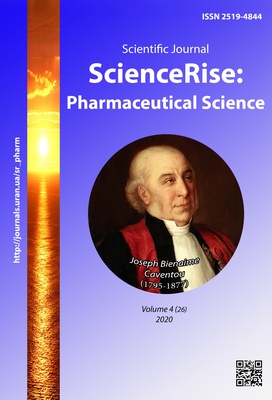Determination of diphenhydramine by HPLC method in biological liquids
DOI:
https://doi.org/10.15587/2519-4852.2020.210728Keywords:
diphenhydramine hydrochloride, extraction with chloroform, analysis by HPLC method, blood, urineAbstract
The aim of the study was to develop an algorithm for directed analysis of diphenhydramine in biological extracts from urine and blood using a unified method of HPLC research.
Materials and methods. The extraction of diphenhydramine was carried out with chloroform at pH 9.0. The extracts were purified from impurities by a combination of TLC and extraction with hexane. TLC purification and identification of diphenhydramine were carried out under optimal conditions: organic solvents systems – chloroform-methanol (90:10); methanol; methanol-25 % solution of ammonium hydroxide (100:1.5) and chromatographic plates - Sorbfil PTLC-AF-A, Sorbfil PTLC-P-B-UV. For the detection of diphenhydramine, the most sensitive location reagents were used - UV light (λ = 254 nm) and Dragendorff reagent in the modification of Mounier.
HPLC analysis was carried out on a microcolumn liquid chromatograph "Milichrome A-02" in conditions: reversed-phase variant, column with non-polar sorbent Prontosil 120-5 C18 AQ, 5 μm; mobile phase in the mode of linear gradient – from eluent А (5 % acetonitrile and 95 % buffer solution) to eluent B (100 % acetonitrile) as during 40 min. The flow rate of the mobile phase has been formed 100 μl/min, injection volume – 4 μl. Multichannel detection of the substance was carried out using a UV spectrophotometer at 210, 220, 230, 240, 250, 260, 280 and 300 nm; the optimal value of column temperature – 37 - 40°С and pressure of pump – 2.8 – 3.2 MPa.
Results and its discussion. Extraction, purification, identification and quantitative determination of diphenhydramine were carried out according to the developed methods. It is established that when isolating diphenhydramine from blood according to the developed methods it is possible to allocate 34.2 – 38.4 % of substance ( = ± 5.69 %, RSD = 2.04 %) and from urine – 55.8 – 60.5 % of substance ( = ± 3.91 %, RSD = 1.40 % ).
Conclusions. An algorithm has been developed for directed analysis of diphenhydramine in biological extracts from urine and blood using a unified HPLC method. Statistical processing of the experimental results indicates the reliability and reproducibility of the technique
References
- Mashkovskii, M. D. (2012). Lekarstvennye sredstva. Moscow: Novaia Volna, 1216.
- Luss, L. V. (2016). Choice of an antihistamine administration route in the treatment of allergic diseases. Terapevticheskii Arkhiv, 88 (3), 93–95. doi: http://doi.org/10.17116/terarkh201688393-95
- Sawicka, K. M., Goez, H., Huntsman, R. J. (2016). Successful Treatment of Paroxysmal Movement Disorders of Infancy With Dimenhydrinate and Diphenhydramine. Pediatric Neurology, 56, 72–75. doi: http://doi.org/10.1016/j.pediatrneurol.2015.10.019
- Li, Y.-Y., Zeng, Y.-S., Chen, J.-Y., Wang, K.-F., Hsing, C.-H., Wu, W.-J. et. al. (2019). Prophylactic diphenhydramine attenuates postoperative catheter-related bladder discomfort in patients undergoing gynecologic laparoscopic surgery: a randomized double-blind clinical study. Journal of Anesthesia, 34 (2), 232–237. doi: http://doi.org/10.1007/s00540-019-02724-3
- Pickett, L. E., Macdonald, J. (2016). Injectable Diphenhydramine Used as Anaesthetic for Wide Local Excision With Flap Closure. Journal of Cutaneous Medicine and Surgery, 21 (3), 256–257. doi: http://doi.org/10.1177/1203475416681760
- Drogovoz, S. M., Lukianchuk, V. D., SHerman, B. S., Kononenko A. V. (2012). Toksicheskie effekty blokatorov N1 – gistaminovykh retseptorov i mekhanizmy ikh formirovaniia. Sovremennye problemy toksikologii, 3-4, 58–59.
- Thomas, S. H. L. (2012). Antihistamine poisoning. Medicine, 40 (3), 109–110. doi: http://doi.org/10.1016/j.mpmed.2011.12.012
- Varma, A., Ford, L., Patel, N., Vale, J. A. (2017). Elimination half-life of diphenhydramine in overdose. Clinical Toxicology, 55 (6), 615–616. doi: http://doi.org/10.1080/15563650.2017.1296153
- Cherukuri, S. V., Purvis, A. W., Tosto, S. T., Velayati, A. (2019). IV Lipid Emulsion Infusion in the Treatment of Severe Diphenhydramine Overdose. American Journal of Case Reports, 20, 758–763. doi: http://doi.org/10.12659/ajcr.912523
- Namazova-Baranova, L. S. (2009). Smertnost ot antigistaminnykh preparatov pervogo pokoleniia. Pozitsiia reguliatornykh organov. Pozitsiia vracha-pediatra. Pediatricheskaia farmakologiia, 6 (3), 52.
- Zagorodniy, S. L., Vasyuk, S. O. (2015). Validation of quantitative determination methods of diphenhyramine tablets by high performance liquid chromatography. Zaporozhye Medical Journal, 2 (89), 89–92. doi: http://doi.org/10.14739/2310-1210.2015.2.42122
- Zhiliakova, E. T., Zinchenko A. A., Novikov, O. O., Popov, N. N. (2015). Razrabotka metodiki opredeleniia miramistina i dimedrola v novykh prolongirovannykh glaznykh kapliakh dlia lecheniia bakterialnykh koniuktivitov. Nauchnye vedomosti Belgorodskogo gosudarstvennogo universiteta. Seriia: Meditsina. Farmatsiia, 30 (10), 211–217.
- Grigorev, A. M., Mashkova, I. V., Rudakova, L. V. (2008). Opredelenie metabolitov dimedrola metodami GKH-MS i VEZHKH v moche. Sorbtsionnye i khromatograficheskie protsessy, 8 (1), 134–140.
- Gelotte, C. K., Zimmerman, B. A., Thompson, G. A. (2017). Single-Dose Pharmacokinetic Study of Diphenhydramine HCl in Children and Adolescents. Clinical Pharmacology in Drug Development, 7 (4), 400–407. doi: http://doi.org/10.1002/cpdd.391
- Krupina, N. A., Krasnova, R. R., Pashovkina, R. N. (2005). Khimiko-toksikologicheskii analiz lekarstvennykh veschestv v krovi (plazme, syvorotke) metodom vysokoeffektivnoi zhidkostnoi khromatografii. Perspektivy razvitiia i sovershenstvovaniia sudebno-meditsinskoi nauki i praktiki. Tiumen, 316.
- Melentev, A. B. (2002). Skrining lekarstvennykh, narkoticheskikh veschestv i ikh metabolitov metodom gazovoi khromatografii s mass-selektivnym detektorom. Problemy ekspertizy v meditsine, 2 (4), 15–20.
- Derzhavna Farmakopeia Ukrainy (2004). DP «Naukovo-ekspertnyi farmakopeinyi tsentr». Kharkiv: RIREH, 520.
- Clarke, E. J. C. (2011). Isolation and Identification of Drugs in Pharmaceuticals, Body Fluids and Postmortem Materia. London: The Pharm. Press, 2463.
- Tomarovskaya, T. O., Mamina, O. O., Kabachny, V. I. (2018). The choice of optimal conditions for chemical-toxicological analysis of diphenhydramine by the thin-layer chromatography. Science and Society. Hamilton, 194–200.
- Baram, G. I. (2005). KHromatograf «Milikhrom A–02». Opredelenie veschestv s primeneniem baz dannykh «VEZHKH–UF». Novosibirsk: ZAO Institut khromatografii, 64.
- Mаmina, O. O., Kabachny, V. I., Bondarenko, N. Yu. (2019). The determination of dimedrol by the HPLC method. Advances of science. Karlovy Vary – Kyiv, 91–101.
Downloads
Published
How to Cite
Issue
Section
License
Copyright (c) 2020 Оlena Mamina, Volodimir Kabachny, Tetyana Tomarovska, Natalya Bondarenko

This work is licensed under a Creative Commons Attribution 4.0 International License.
Our journal abides by the Creative Commons CC BY copyright rights and permissions for open access journals.








